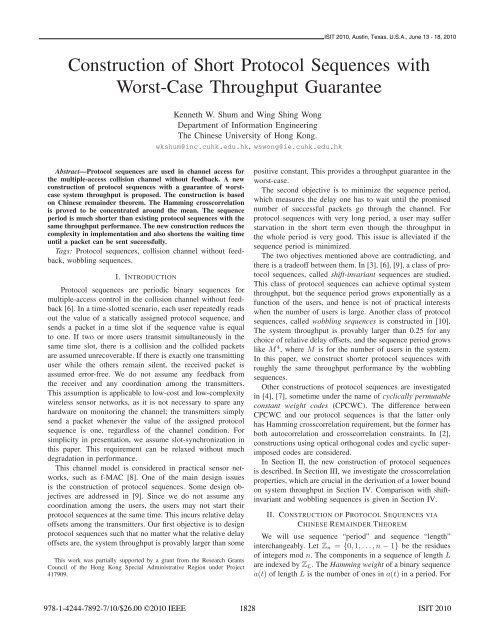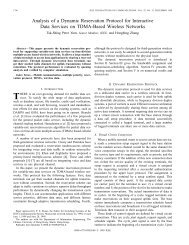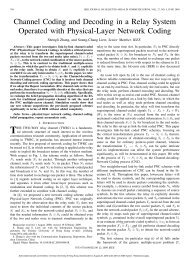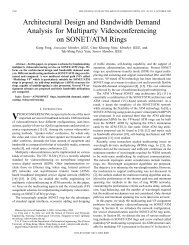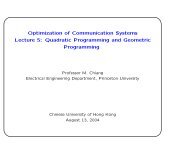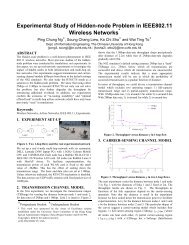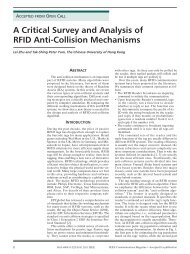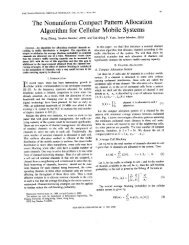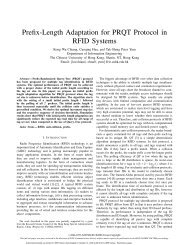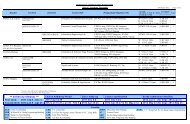Construction of Short Protocol Sequences with Worst ... - IEEE Xplore
Construction of Short Protocol Sequences with Worst ... - IEEE Xplore
Construction of Short Protocol Sequences with Worst ... - IEEE Xplore
You also want an ePaper? Increase the reach of your titles
YUMPU automatically turns print PDFs into web optimized ePapers that Google loves.
ISIT 2010, Austin, Texas, U.S.A., June 13 - 18, 2010<br />
<strong>Construction</strong> <strong>of</strong> <strong>Short</strong> <strong>Protocol</strong> <strong>Sequences</strong> <strong>with</strong><br />
<strong>Worst</strong>-Case Throughput Guarantee<br />
Kenneth W. Shum and Wing Shing Wong<br />
Department <strong>of</strong> Information Engineering<br />
The Chinese University <strong>of</strong> Hong Kong.<br />
wkshum@inc.cuhk.edu.hk, wswong@ie.cuhk.edu.hk<br />
Abstract—<strong>Protocol</strong> sequences are used in channel access for<br />
the multiple-access collision channel <strong>with</strong>out feedback. A new<br />
construction <strong>of</strong> protocol sequences <strong>with</strong> a guarantee <strong>of</strong> worstcase<br />
system throughput is proposed. The construction is based<br />
on Chinese remainder theorem. The Hamming crosscorrelation<br />
is proved to be concentrated around the mean. The sequence<br />
period is much shorter than existing protocol sequences <strong>with</strong> the<br />
same throughput performance. The new construction reduces the<br />
complexity in implementation and also shortens the waiting time<br />
until a packet can be sent successfully.<br />
Tags: <strong>Protocol</strong> sequences, collision channel <strong>with</strong>out feedback,<br />
wobbling sequences.<br />
I. INTRODUCTION<br />
<strong>Protocol</strong> sequences are periodic binary sequences for<br />
multiple-access control in the collision channel <strong>with</strong>out feedback<br />
[6]. In a time-slotted scenario, each user repeatedly reads<br />
out the value <strong>of</strong> a statically assigned protocol sequence, and<br />
sends a packet in a time slot if the sequence value is equal<br />
to one. If two or more users transmit simultaneously in the<br />
same time slot, there is a collision and the collided packets<br />
are assumed unrecoverable. If there is exactly one transmitting<br />
user while the others remain silent, the received packet is<br />
assumed error-free. We do not assume any feedback from<br />
the receiver and any coordination among the transmitters.<br />
This assumption is applicable to low-cost and low-complexity<br />
wireless sensor networks, as it is not necessary to spare any<br />
hardware on monitoring the channel; the transmitters simply<br />
send a packet whenever the value <strong>of</strong> the assigned protocol<br />
sequence is one, regardless <strong>of</strong> the channel condition. For<br />
simplicity in presentation, we assume slot-synchronization in<br />
this paper. This requirement can be relaxed <strong>with</strong>out much<br />
degradation in performance.<br />
This channel model is considered in practical sensor networks,<br />
such as f-MAC [8]. One <strong>of</strong> the main design issues<br />
is the construction <strong>of</strong> protocol sequences. Some design objectives<br />
are addressed in [9]. Since we do not assume any<br />
coordination among the users, the users may not start their<br />
protocol sequences at the same time. This incurs relative delay<br />
<strong>of</strong>fsets among the transmitters. Our first objective is to design<br />
protocol sequences such that no matter what the relative delay<br />
<strong>of</strong>fsets are, the system throughput is provably larger than some<br />
This work was partially supported by a grant from the Research Grants<br />
Council <strong>of</strong> the Hong Kong Special Administrative Region under Project<br />
417909.<br />
positive constant. This provides a throughput guarantee in the<br />
worst-case.<br />
The second objective is to minimize the sequence period,<br />
which measures the delay one has to wait until the promised<br />
number <strong>of</strong> successful packets go through the channel. For<br />
protocol sequences <strong>with</strong> very long period, a user may suffer<br />
starvation in the short term even though the throughput in<br />
the whole period is very good. This issue is alleviated if the<br />
sequence period is minimized.<br />
The two objectives mentioned above are contradicting, and<br />
there is a trade<strong>of</strong>f between them. In [3], [6], [9], a class <strong>of</strong> protocol<br />
sequences, called shift-invariant sequences are studied.<br />
This class <strong>of</strong> protocol sequences can achieve optimal system<br />
throughput, but the sequence period grows exponentially as a<br />
function <strong>of</strong> the users, and hence is not <strong>of</strong> practical interests<br />
when the number <strong>of</strong> users is large. Another class <strong>of</strong> protocol<br />
sequences, called wobbling sequences is constructed in [10].<br />
The system throughput is provably larger than 0.25 for any<br />
choice <strong>of</strong> relative delay <strong>of</strong>fsets, and the sequence period grows<br />
like M 4 , where M is for the number <strong>of</strong> users in the system.<br />
In this paper, we construct shorter protocol sequences <strong>with</strong><br />
roughly the same throughput performance by the wobbling<br />
sequences.<br />
Other constructions <strong>of</strong> protocol sequences are investigated<br />
in [4], [7], sometime under the name <strong>of</strong> cyclically permutable<br />
constant weight codes (CPCWC). The difference between<br />
CPCWC and our protocol sequences is that the latter only<br />
has Hamming crosscorrelation requirement, but the former has<br />
both autocorrelation and crosscorrelation constraints. In [2],<br />
constructions using optical orthogonal codes and cyclic superimposed<br />
codes are considered.<br />
In Section II, the new construction <strong>of</strong> protocol sequences<br />
is described. In Section III, we investigate the crosscorrelation<br />
properties, which are crucial in the derivation <strong>of</strong> a lower bound<br />
on system throughput in Section IV. Comparison <strong>with</strong> shiftinvariant<br />
and wobbling sequences is given in Section IV.<br />
II. CONSTRUCTION OF PROTOCOL SEQUENCES VIA<br />
CHINESE REMAINDER THEOREM<br />
We will use sequence “period” and sequence “length”<br />
interchangeably. Let Z n = {0, 1,...,n− 1} be the residues<br />
<strong>of</strong> integers mod n. The components in a sequence <strong>of</strong> length L<br />
are indexed by Z L . The Hamming weight <strong>of</strong> a binary sequence<br />
a(t) <strong>of</strong> length L is the number <strong>of</strong> ones in a(t) in a period. For<br />
978-1-4244-7892-7/10/$26.00 ©2010 <strong>IEEE</strong> 1828<br />
ISIT 2010
ISIT 2010, Austin, Texas, U.S.A., June 13 - 18, 2010<br />
two binary sequences a(t) and b(t) <strong>of</strong> length L, their Hamming<br />
crosscorrelation function is defined as<br />
H ab (τ) := ∑<br />
a(t)b(t + τ),<br />
t∈Z L<br />
where τ is the delay <strong>of</strong>fset.<br />
We shall construct sequences <strong>with</strong> length L = pq, where<br />
p and q are two relatively prime integers. In this paper, we<br />
will take p to be a prime number and q an positive integer not<br />
divisible by p. By the Chinese Remainder Theorem (CRT) [5],<br />
there is a bijection between Z pq and the direct sum<br />
G p,q := Z p ⊕ Z q .<br />
The bijective mapping Φ:Z pq → G p,q is given by<br />
Φ(x) =(x mod p, x mod q).<br />
Henceforth, we will identify Z pq <strong>with</strong> G p,q .<br />
CRT <strong>Construction</strong> Given a prime number p and an integer<br />
q relatively prime to p, we define a sequence s g (t) <strong>of</strong> length<br />
pq, for g =0, 1, 2 ...,p− 1, by<br />
s g (t) :=<br />
{<br />
1 Φ(t) =(¯jg,j) for some j, 0 ≤ j
ISIT 2010, Austin, Texas, U.S.A., June 13 - 18, 2010<br />
For each fixed τ 2 ,asτ 1 runs through Z p , h −1 τ 1 also runs<br />
through the complete set <strong>of</strong> residues mod p. Therefore, the<br />
distribution <strong>of</strong> Hamming crosscorrelation between s g (t) and<br />
s h (t) is the same as the distribution <strong>of</strong> Hamming crosscorrelation<br />
between s g/h (t) and s 1 (t). We henceforth focus<br />
on the case h =1<strong>with</strong>out any loss <strong>of</strong> generality.<br />
To aid the derivation <strong>of</strong> the Hamming crosscorrelation, we<br />
first prove the following lemma.<br />
Lemma 2. Let g ∈ Z p \{1}, and denote Φ(τ) by (τ 1 ,τ 2 ). The<br />
Hamming crosscorrelation between s g (t) and s 1 (t), namely<br />
H g1 (τ), satisfies the following properties:<br />
1) H g1 (τ) equals the number <strong>of</strong> solutions to<br />
¯x ≡ a g (τ 1 ,τ 2 )+b g I(0 ≤ x
ISIT 2010, Austin, Texas, U.S.A., June 13 - 18, 2010<br />
This contradicts <strong>with</strong> (12) and proves the claim. For<br />
¯q ≤ x
ISIT 2010, Austin, Texas, U.S.A., June 13 - 18, 2010<br />
Theorem 4. Let p be a prime number, k ≥ 2, and M ′ be the<br />
largest integer smaller than or equal to M ∗ in (18). By picking<br />
M ′ sequences from the CRT construction <strong>with</strong> parameters p<br />
and q = kp − 1, the system throughput is lower bounded by<br />
1<br />
p(kp − 1)<br />
[ (p +1)<br />
2<br />
·<br />
4<br />
k 2<br />
]<br />
k +1 − (k +1)<br />
(19)<br />
Pro<strong>of</strong>: Consider the expression in (16) as a function <strong>of</strong><br />
M, and denote it by f(M). Since the difference between M ∗<br />
and M ′ is at most one, f(M ∗ )−f(M ′ ) ≤ (k+1)(M ′ −M ∗ ) ≤<br />
k +1. After division by the period p(kp − 1), wehavethe<br />
following lower bound on system throughput,<br />
f(M ′ )<br />
p(kp − 1) ≥ f(M ∗ ) − (k +1)<br />
p(kp − 1)<br />
which can be readily seen to be the same as (19).<br />
We note that the value in (19) is approximately equal to<br />
0.25 when k and p are large.<br />
Theorem 4 provides a hard guarantee on the worst-case<br />
system throughput; no matter what the delay <strong>of</strong>fsets are, the<br />
system throughput is always larger than the value in (19).<br />
Theorem 4 also indicates a trade<strong>of</strong>f between the the lower<br />
bound and the sequence period. If we increase the value <strong>of</strong><br />
k, the sequence period is increased, but the lower bound on<br />
system throughput is also increased.<br />
We remark that the lower bound in Theorem 4 is not<br />
tight. The actual system throughput is higher than (19). The<br />
next example compares the lower bound <strong>with</strong> the average<br />
throughput over relative delay <strong>of</strong>fsets.<br />
Example 2. We consider an example <strong>with</strong> M =19users,<br />
using CRT sequences <strong>with</strong> p = 37 and q = kp − 1.<br />
The throughput is plotted against the sequence period, while<br />
keeping the fraction <strong>of</strong> ones in each sequence fixed at 1/p. This<br />
means that the fraction <strong>of</strong> time in which a user is transmitting,<br />
and hence the power <strong>of</strong> each user, is kept constant. We<br />
compare the lower bound in (19) <strong>with</strong> the average throughput<br />
obtained by simulation in Fig. 1. For each k, 20000 delay<br />
<strong>of</strong>fset combinations are randomly generated. The mean system<br />
throughput is about 0.31 In addition to the mean throughput,<br />
the maximum and minimum throughput obtained among these<br />
20000 delay <strong>of</strong>fset combinations are also plotted. The variation<br />
<strong>of</strong> throughput diminishes as sequence period increases. The<br />
value <strong>of</strong> the lower bound (19) also increases. We see that the<br />
minimal observed system throughput is much higher than the<br />
lower bound in Theorem 4.<br />
For the shift-invariant protocol sequence set for nineteen<br />
users, the sequence period is 19 19 , which is astronomical.<br />
Nevertheless, it has higher system throughput e −1 =0.3679.<br />
For wobbling sequences, a lower bound <strong>of</strong> 0.25 system<br />
throughput [10, (6.12)] is guaranteed when the sequence<br />
period is 19 4 ≈ 1.3×10 5 . From Fig. 1, a lower bound <strong>of</strong> 0.25<br />
can be obtained by using CRT sequences when the sequence<br />
period is about 1.1 × 10 4 , a roughly ten-fold reduction in<br />
sequence period.<br />
Throughput<br />
0.4<br />
0.35<br />
0.3<br />
0.25<br />
0.2<br />
Max observed throughput<br />
Mean throughput<br />
0.15<br />
Min observed throughput<br />
Lower bound<br />
0.1<br />
10 3 10 4<br />
Sequence Peirod<br />
Fig. 1. System Throughput <strong>of</strong> CRT <strong>Sequences</strong> for M =19users, p =37.<br />
V. CONCLUSION<br />
In order to minimize the waiting time until a successful<br />
packet is sent, while maintaining a high level <strong>of</strong> system<br />
throughput, a class <strong>of</strong> protocol sequences <strong>with</strong> short period are<br />
constructed. After analyzing the crosscorrelation properties,<br />
we derive a lower bound on the system throughput. The constructed<br />
sequences provides flexibility on the trade<strong>of</strong>f between<br />
sequence period and the worst-case system throughput.<br />
REFERENCES<br />
[1] N. Q. A, L. Györfi, and J. L. Massey, “<strong>Construction</strong>s <strong>of</strong> binary constantweight<br />
cyclic codes and cyclically permutable codes,” <strong>IEEE</strong> Trans.<br />
Inform. Theory, vol. 38, no. 3, pp. 940–949, May 1992.<br />
[2] W. Chu, C. J. Colbourn, and V. R. Syrotiuk, “Slot synchronized<br />
topology-transparent scheduling for sensor networks,” Computer Communications,<br />
vol. 29, no. 4, pp. 421–428, Feb. 2006.<br />
[3] V. C. da Rocha, Jr., “<strong>Protocol</strong> sequences for collision channel <strong>with</strong>out<br />
feedback,” IEE Electron. Lett., vol. 36, no. 24, pp. 2010–2012, Nov.<br />
2000.<br />
[4] L. Gyöfi and I. Vajda, “<strong>Construction</strong> <strong>of</strong> protocol sequences for multipleaccess<br />
collision channel <strong>with</strong>out feedback,” <strong>IEEE</strong> Trans. Inform. Theory,<br />
vol. 39, no. 5, pp. 1762–1765, Sep. 1993.<br />
[5] K. Ireland and M. Rosen, A Classical Introduction to Modern Number<br />
Theory. New York: Springer-Verlag, 1990.<br />
[6] J. L. Massey and P. Mathys, “The collision channel <strong>with</strong>out feedback,”<br />
<strong>IEEE</strong> Trans. Inform. Theory, vol. 31, no. 2, pp. 192–204, Mar. 1985.<br />
[7] O. Moreno, Z. Zhang, P. V. Kumar, and V. A. Zinoviev, “New constructions<br />
<strong>of</strong> optimal cyclically permutable constant weight codes,” <strong>IEEE</strong><br />
Trans. Inform. Theory, vol. 41, no. 2, pp. 448–455, Mar. 1995.<br />
[8] U. Roedig, A. Barroso, and C. J. Sreenan, “f-MAC: A deterministic<br />
media access control protocol <strong>with</strong>out time synchronization,” in 3rd<br />
European Workshop on Wireless Sensor Networks, ser. Lecture Notes<br />
in Computer Science, K. Römer, H. Karl, and F. Mattern, Eds., no.<br />
3868. Berlin: Springer-Verlag, 2006, pp. 276–291.<br />
[9] K. W. Shum, W. S. Wong, C. W. Sung, and C. S. Chen, “Design and<br />
construction <strong>of</strong> protocol sequences: Shift invariance and user irrepressibility,”<br />
in <strong>IEEE</strong> Int. Symp. Inform. Theory, Seoul, Jun. 2009, pp. 1368–<br />
1372.<br />
[10] W. S. Wong, “New protocol sequences for random access channels<br />
<strong>with</strong>out feedback,” <strong>IEEE</strong> Trans. Inform. Theory, vol. 53, no. 6, pp. 2060–<br />
2071, Jun. 2007.<br />
1832


